
|
Lorna Mills and Sally McKay
Digital Media Tree this blog's archive OVVLvverk Lorna Mills: Artworks / Persona Volare / contact Sally McKay: GIFS / cv and contact |
View current page
...more recent posts
Rob Cruickshank is installing work at Fly Gallery this weekend. I've seen a tantalizing blue spiral in mpeg preview form, and I'm looking forward to the real thing. I very much liked the piece Rob and Sarah Peebles did this summer, and of course if you don't regularly check his blog, Endless Parade of Excellence, then you are working far far too hard and really ought to adjust your priorities. Fly is operated by Tanya Read (see post below) and fellow artist Scott Caruthers. It's a walk-by window display on Queen West, between The Drake Hotel and the Gladstone Hotel, north side. If you are in Toronto, go by Fly in January and take a look.
NB: Let me declare up front that Rob, Tanya, and Scott are all friends of mine, and I will be showing at Fly Gallery myself in April. More posts about artists I've never met coming soon in 2005.
There's a great big story about Mr. Nobody in the Globe today! Gary Michael Dault did a good job filling in the back story on the enigmatic little guy, and there's some nice quotes from Tanya Read, Mr. Nobody's Frankenstein-like creator.
[Mr. Nobody's appeal] has a lot to do with his existential determination, in the way he just keeps going, persisting in the face of futility.Last spring I wrote a short exhibition essay for Tanya Read's show at Truck Gallery in Calgary. Here's a quote:
Recently, Mr. Nobody has acquired an Ignatz mouse, a yin for his yang, a perfect foil. In the film Juggernaut, a monstrous ball appears with dots that might be eyes, mouth, snout or belly but never quite resolving into form, an indominatable abstraction that rolls over Mr. Nobody and leaves him flat and blinking.You can watch Juggernaut online here at the Mr. Nobody website. NB: I also made a wee post on Mr. Nobody here back in May.
Kristin Lucas's top ten art picks for 2004
(listed in the order that she witnessed them)
1. Tom Moody online
http://www.digitalmediatree.com/tommoody/
2. Joe McKay's "Accidental MPegs". VertexList, Brooklyn, NY. January.
3. Paper Rad at Foxy Production, NY. April - May.
http://www.foxyproduction.com/ExhibitionPaperRad.html
4. Lisa Choinacky's "My Bodyguard". A drawing of a person about to take off on a motorcycle. Riding double is blue bear. Also her encaustic paintings of album covers. I bought "The Pretenders." Both works on presented by Fresh Up Club in Austin, TX. February and April.
5. Wangeshi Mutu, collage work
The Altoids Collection tour at ArtHouse Texas in Austin, TX. April. http://www.africana.com/articles/qa/ar20030305mutu.asp
6. Jude Tallichet's "It's All Good" from "Treble" exhibtion at Sculpture Center, NY. Curated by Regine Basha. May.
A pink and white pearl drum set hung upside down from the ceiling like a chandelier.
http://www.sculpture-center.org/pe_treble_img1.html
(roll over the images to 'no. 15' though not a great pic)
7. 2nd Grade Toy Inventions at Creative Research Laboratory in Austin, TX. "Now and Tomorrow" exhibition. June.
The Education Program of CRL in Austin worked with school teachers who then conducted art projects with students pre-kindergarden to 12th grade. My favorite was the 2nd grade project. They invented thier own toys, and exhibited them as if they were pitching them: a drawing, clay model, and a marketing profile outlining materials, noise, how to use it, age req., special effects, cost). My favorite toy was titled "Monkey". According to the available information, you throw it and it screams.
From the Austin Chronicle: "Alfred Galvan's Discoman, a blue and gold doll bursting with disco magic, is designed to be made of "plastic and solid gold" and sold for $4,000 under the slogan "Little Children Out of Site.""
8. The Infinite Fill Show at Foxy Production, NY.
My favorite works were Michael Bell-Smith's animation and Ryan Compton's hand-drawn sneakers on a brick wall pattern. July - Aug.
http://www.foxyproduction.com/Infinite.htm
9. Scott Hewicker's napkin drawings of cats with laser eyes. I keep finding them lying around abandonned. San Francisco, CA. Beginning in October.
10. Jovi Schnell at The Luggage Store Gallery in San Francisco, CA. November.
LM's top ten (in no particular order)
1. Cafka.04 or any year! Everything you want to see in a group show in a Civic centre, excited artists and an excited public.
http://www.contemporaryartforum.ca/main/main.html
2. Wade - Another terrific group project, and I agree with Sally that the misanthropic Gene Threndyle did a marvellous piece.
http://www.digitalmediatree.com/sallymckay/?28096
3. Daniel Barrow "The face of Everything" closing night at Images Festival.
His own web site is: http://www.danielbarrow.com
4. Kate Wilson's "Cool Lustre" at Katharine Mulherin (I like the greasy paintings the best!)
http://168.144.171.147/kmart/exhibitions/a_artist.asp?id=167
Her listing on the CCCA site is: http://www.ccca.ca/artists/artist_info.html?languagePref=en&link_id=5492&artist=Kate+Wilson
5. David Shrigley's transit posters up around Toronto during the Contact festival.
His own web site is: http://www.davidshrigley.com/
6. John Dickson's "Cold War" at Cambridge galleries http://www.cambridgegalleries.ca/cambridge.taf?section=2
(probably because I saw "Das Boot" seven times and cried when the Kursk sunk.)
7. Julie Voyce at AGYU
http://www.yorku.ca/agyu/exhibitions/wiflfag.html
8. 640 480 video embroidery machine at Zsa Zsa
http://www.640480.com
9. Fastwurms with Michael Barker at Zsa Zsa, loved the wood grained mac-tac pirate ship wall and loved Andrew Harwood's moving role in the video as man-dressed-as-a-pirate-waving-a-phoney-sword-and-yelling-aaaaarrrrrrgggggggg
10. Going to the local video store, just looking to rent some fluffy movie with costumes, and picking up Alexander Sokurov's "Russian Ark", watched it three times that evening, once with the commentary, then watched the "making of...", then brought it over to a friend's house and watched it again, (but probably spoiled the whole experience for her, since I wouldn't shut up about it.)
Tino's Top Ten art picks for 2004:
1. Rev Billy at XSpace, International Festival of Performance Art
http://www.7a-11d.ca/2004/2004.html
Riveting performance in front of a packed house. Followed by an anti-corporate intervention after the show. Inspiring.
http://www.nowtoronto.com/issues/2004-11-04/news_story8.php
http://www.revbilly.com
2. Kurt Swinghammer: Augusta CD
Sweet, nostalgic and best written album bout Toronto since Scott B's "Neil Yonge Street".
http://www.swinghammer.com/
3. Olia Mischenko Mercer Union
Olias' other-worldly miniature drawings were literally being rubbed off the walls by peoples' noses that night.
http://www.mercerunion.org/show.asp?show_id=102
4. Kraftwerk, Ricoh Coliseum, Toronto
Visually stunning music.
http://www.tecnopolis.ca/gallery/Toronto-2004?page=11
http://www.kraftwerk.com
5. Poster Korea, FearonRevell Projects
Two Canadians teaching in Korea bring along a suitcase of posters from Canada and liven up the Seoul.
http://www.fearonrevellprojects.org/poster/index.htm
6. Toronto Graffiti Art Scene - Style in Progress Festival, July 2-4
It just gets better and better. Empty walls say nothing.
http://www.styleinprogress.ca/
7. Cloaca Wim Delvoyle, Power Plant Gallery
Surprise. We are the art. Wim said: 'In New York, they were all worried about the hygienic aspects of the machine. In Europe, people just wanted to know what it all meant. In Toronto, they just ask: "How does it work?"
http://www.cloaca.be/
8. Graeme Perry: Laneing (Web Project)
Most inspiring online project. Documenting the underbelly of Toronto.
http://www.graemeparry.com/laneways/maps/center/center.html
9. Toronto Subway Station Buttons, Public Space Committee
Simple, brilliant and fun.
http://www.spacing.ca/buttons.htm
10. Chester Brown - Louis Riel
Best graphic novel of 2004. Hands down, we're taking over HBC.
http://www.arts.uwaterloo.ca/~raha/392AF04_web/04-Lam/louis.html
(Note: This link features an online version of the book!)



Images from The Elegant Universe
String theory kind of bugs me. Or maybe its just the latest offering from the ever-charismatic string theory guru Brian Greene that I found mildly irksome; the three-part TV series version of his book The Elegant Universe. A good friend gave it to me on tape (thank you friend), but Goodreads has posted a link to the episodes online. String theory is pretty groovy: the idea that the fundamental elements of the universe are not tiny particles at all, but vibrating loops. Maybe I'm just crabby cause of Christmas, but the show kind of turned me off the concept.
The show is a science graphics extravaganza. We are continually bombarded with the invitation to "picture" this and "imagine" that. I began to get the feeling that in any given instance, almost any analogy would do. Instead of falling apples to indicate gravity, how about anvils? Instead of slices of bread to indicate parallel universes, how about an ever expanding playlist of different mp3s? The art direction was very catchy but the visual themes seemed haphazard and I started to doubt the use of eye-candy in wrestling with abstractions.* And by extension I started to doubt string theory itself.
Is it a massive stretch to compare theories with pictures? Theories, like Einstein's theory of relativity, or Heisenberg's Uncertainty Principle, do function as a kind of representation. Like a model, or a diagram, they give us a means of sorting information into a configuration that carries meaning. As a lay person absorbing flashy science for a general audience,I am not required to go through the rigours of proving any theories. That's a problem, because I start to see the theories as interchangeable bits of culture, rather than tested modules of scientific knowledge with evidence attached. I do realize that lot of people do a lot of long boring computations on an ongoing basis just so that we can all adopt one theory over the next. And the same goes for string theory. (And the calculations balance!) But, unlike quarks and neutrinos, it just isn't possible to test empirically for evidence of strings.
I wonder, could we just as easily think of the universe as made up of tiny thumb tacks, tacks that poke into the fabric of space time and attach on pieces of other dimensions, so that the universe piles up like layers on an overstuffed bulletin board? Or maybe the universe is made up of cat hairs, that clump into balls in some places, like under the couch, but float freely as individual strips, carrying all kinds of microscopic information as they settle in your spaghetti sauce, or on the bosom of your best black dress. If we spent five hundred years doing the calculations on such a model, is there a chance that we could get the mathematics to work out? I know I'm out on a limb, but I don't think I'm alone in feeling that string theory, at least in the context of Brian Greene's TV show, is just a tad too self-reflexive. There's another word for that...oh yeah, elegant!
(*This could pose a problem for me, since making art images derived from science ideas is one of my ongoing projects.)

Merry Christmas Monster Teeth
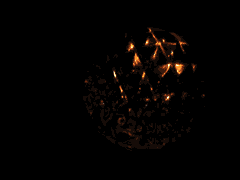
| 
|
Timothy Comeau's Top Ten art picks for 2004:
1. David Hoffos at TPW in September
2. The Fuck New York video and it's followup
3. Hive party in June at Studio 99
4. Niagara Falls Artist Program at Mercer Union in December
5. Allyson Mitchell's show at Paul Petro in March
6. Fastwurms with Michael Barker at Zsa Zsa at the end of August (the canon blew smoke!)
7. French bookstores in Montreal
8. Diane Landry at YYZ
9. Instant Coffee's make out party in March
10. Realizing that the new OCAD building was great when I wanted to show it off to a visiting friend from out of town.
Kineko Ivic's top 10 picks in no particular order:
1. Brad Phillips: Silver Springs at Greener Pastures
2. Frieze Art Fair London
3. Tal R at CFA Berlin
4. Erik Parker at Leo Koenig NY
5. Daniel Richter at Power Plant Toronto
6. Hernan Bas in Miami (Design District)
7. New bar for the art crowd, Sweaty Betty's (previously Luft Gallery)
8. Strange and quirky shows at Mind Control Toronto
9. Dana Schutz at Zach Feuer Gallery NY
10. the new MOMA, NY
MK's Top 10 of 2004:
1. Nicolas Fleming's "L'histoire d'un vieux sac" (Story of an old bag) at CDEx, Montreal. A beautiful and honest piece, wherein a painter asks questions about his medium by exploring it in a performative context. My top wish for 2005 is to see more artists extending themselves in this way: experimenting without being sloppy; making radical choices but not being careless; and though being somewhat deliberate, still imparting a warm and human sensibility in the work. (http://michelle.kasprzak.ca/blog/entries/archives/00000058.htm)
2. Being one of the ringleaders of Geostash. A high-tech treasure hunt where artists execute actions developed by other artists for specific urban places. It was an experience full of surprises. (http://www.year01.com/geostash)
3. Two things at the Whitney Biennial: Slater Bradley's single channel video installation "Theory and Observation", and Aïda Ruilova's wonderful roomful of short videos. They were two extremes to the show: Bradley's piece was subtle and meditative; Ruilova's were overtly quirky and slapstick. (http://www.whitney.org/biennial/)
4. "Listening Post" at Ars Electronica. This piece won the "Golden Nica" for Interactive Art at Ars Electronica. Except it wasn't interactive at all. The piece did an excellent job highlighting the awkward categorization of new media work at festivals, and it was also a mesmerizing, well-crafted data-choreography piece. (http://earstudio.com/projects/listeningpost.html)
5. John Kormeling's ferris wheel for cars at the Power Plant. Wheee! (http://michelle.kasprzak.ca/blog/entries/archives/00000038.htm)
6. Istvan Kantor winning the Governor General's award. Proof that the awards have not lost their edge. (http://www.cbc.ca/arts/stories/govgenart030304)
7. The Guggenheim's "Seeing Double: Emulation in Theory and Practice" show. This show, that concerned itself with ephemerality and particularly the problem of preserving digital art, was interesting but most of it didn't work. It was somehow comforting that not even the Guggenheim could just wave its magic wand and bring all these wayward pieces into line. Many questions without answers, which is nice to see in a big museum. (http://www.guggenheim.org/exhibitions/emulation/index.html)
8. Caroline Martel's "Le Fantôme de l'Opératrice" (The Phantom of the Operator) at the Toronto International Film Festival. A beautifully wrought film chronicling the fate of the telephone operator. (http://www.artifactproductions.ca/)
9. [murmur]'s new installation in the Annex. More psychogeography by phone from the indefatigable [murmur] collective. (http://www.murmur.info)
10. "Pain Couture" at Fondation Cartier, Paris. A whimsical selection of bread meets fashion by Jean-Paul Gaulthier. It was one of those summer "lite" shows, but hey, I'm at number 10 and I'm allowed to start venturing into questionable shows. At least this show titillated the nose as well as the eye: the smell of freshly baked bread was intoxicating. (http://parisvoice.com/04/summer04/html/art/style.cfm)
Sally McKay's Top Ten Art Picks for 2004
(culled from posts on this blog)
1. Judy Radul's installation, Empathy With Victor at the Power Plant was, in my opininion, a brilliant bit of philosophy that deftly folded fiction, fact, and consciousness into a tight narrative package. But what do I know? Anyhow, I was out-voted in the subsequent poll.
2. Copenhagen, the play by Michael Frayne about phsyicists Werner Heisenberg and Neils Bohr, was an intense study of quantum physics in it's romantic, mind-bending power and it's very real power to produce gigantic war-winning, life-destroying bombs. The narrative took a great shift, swinging the onus of evil off of Nazi-employed Heisenberg and onto A-bomb deployer, Bohr, who left Denmark for USA and worked for the Allies.
3. Rat King Mini Rock Opera was Maggie MacDonald's contribution to February's Tin Tin Tin event organised by Carl Wilson. A chorus of chanters in rat-masks. A soulful leading lady with a voice to melt your heart. A scary dad and jittery rat king boyfriend. Who want's more? What more is there?
4. OCAD's Art Criticism Panel spawned a massive slunge of comments on this blog. The question "is art criticism dead?" really hit a nerve. The topic has been popping up all over the place, and while many find that the murky abstractions of this discussion set their teeth on edge, I totally dig it.
5. Kraftwerk ...damn that was good!
6. Triplets of Belleville was screened in the park by CBN. Nothing beats sitting around on the damp grass with a bunch of other chilly, drunken cyclists. Really!
7. Gene Threndyle's piece for Wade took place in the same park as the screening listed above. Trinity Bellwoods Park is smallish by some standards, but well-used. Sports, culture, dogs, kids, and just plain sitting around all seem to find enough space. I spent most of my time off at TBP this summer, but this particular afternoon, with scads of killer whales spinning and drifting in a sunny, watery underworld, ranks as one of my top days in the park.
8. Janet Cardiff's 40 piece motet really blew me away. I keep thinking back on it, particularly the impression I had of a kind of cyborg experience, an electronic delivery of throat and breath and resonance that seemed slighty unnerving in its perfection. Is this mimesis?
9. James Hartle's kooky drawings really break down the boundaries between art and science. It sucks when the scientists can do their own art too! Sigh ... I guess feeling redundant is just part of life on the cultural fringe. Anyhow, Hartle's proficient use of the overhead projector was inspiring for future performance-type projects, and his broken-up cat drawing sparked a fun discussion about Cubism.
10. Lorna Mills' art show spurred a lot of speculative rambling and babbling on my part, and I won't go on about it again now. But I loved that show.
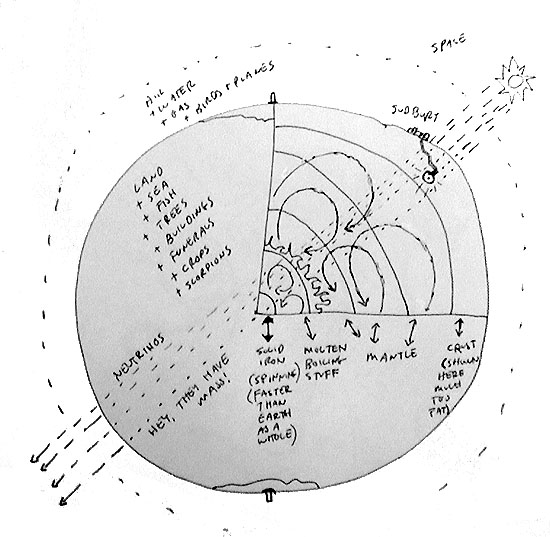

I'm biased because I worked on Caught in the Act in my recent position as interim managing editor at YYZ Books. It's massive, with tons of pictures and profiles. The level of detail is astounding, and if you are looking for contemporary Canadian art context this will give it to you. (I think it was working on this book that kick-started me on my recent-art-history binge...for better or worse!) Editors Johanna Householder and Tanya Mars are indefatiguable, and their hard work gave this landmark book the gift of life. Of course Zab, the designer, went beyond the call and Rob Labossiere, the new managing editor at YYZ, did a bunch of hard work to get it out in time. Here's what YYZ has to say...
Please join us for the launch of this important new title from YYZ Books:
Caught in the Act
an anthology of performance art by Canadian women
Edited by Tanya Mars and Johanna Householder
Thursday, December 16, 7 – 9 p.m.
at YYZ Artists’ Outlet
401 Richmond Street, Suite 140, 416.598.4546
Canada’s definitive book on Canadian women in performance art, this indispensible anthology gives readers access to an important and under-recognized subject in recent Canadian art history. Edited by two seminal Canadian peformance artists, Tanya Mars and Johanna Householder, this book focuses on the 70s and 80s; a time when women made a big and noisy impact, and provides readers with insight into the profound effects that feminism and women’s work have had on the current alternative scene. Full of sass and insight, this essential collection is part survey, part critical discourse, and part reference book, containing five critical essays, thirty-four profiles on individual artists, hundreds of images, and an extensive bibliography.
444 pp. , 219 b/w photos, 19 colour plates
ISBN: 0-920397- 84-0 (softcover) $39.95
YYZ Books is online at www.yyzartistsoutlet.org
YYZ Books is distributed by ABC Art Books Canada at www.abcartbookscanada.com
The support of the Canada Council for the Arts in making this book possible is gratefully acknowledged.
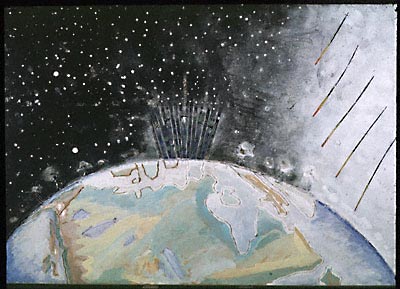 Paterson Ewen, Northern Lights, 1973 (taken from AGO website) | "According to Paterson Ewen only one of his paintings comes from a direct experience -- that of seeing the aurora borealis while snoeshowing in Algonquin Park. And yet that painting, Northern Lights, with the earth seen from space and the land mass of Canada occupying a disproportionate area of the globe, can hardly be said to be a painting of direct experience." - Philip Monk, Phenomena: Paterson Ewen Paintings 1971-19987, exhibition catalogue, (Toronto: Art Gallery of Ontario, 1988), p. 22 |
| Puttering around through old magazines at the library, I found a hard-copy thread of 80s art criticism, controversy and intrigue. Here's the short version: Philip Monk curated a show by Canadian artist Paterson Ewen in 1988, and wrote a catalogue essay that focussed on the semiotic and material aspects of Ewen's work, referring to a number of American artists such as Robert Smithson, Jackson Pollock, Richard Serra and Robert Morris. Canadian artists Greg Curnoe and Andy Patton took great offense to Monk's approach and wrote scathing responses that were printed together in Parachute, summer of 1989. Curnoe accused Monk of "sanitized and a-historical writing," which held Paterson Ewen up to "imagined international criteria," neglecting the "real context of his work and ideas." Patton suggested that Monk was "groping for coherence and literacy at the expense of one of Canada's major painters." Monk responded in the following issue of Parachute, "...I feel that this demand for history and context, rather than letting the work stand in its own right, is an unconsciously envious attempt by Curnoe and Patton to diminish the achievements of Ewen's art." Pretty darn shirty all round! Yet I am really very curious about the larger context. As LM mentioned recently in another thread, the 80s were full of "tyrannical art ideologies." But despite all the emotional lashing out, each piece contains great historical detail and/or art insights. All three of these guys were confident, smart, and engaged. Why do they seem to feel so threatened? Here's a few quick thoughts: Point for PM: The Canadian art world was so clique-dependent, that for a critic to suggest one particular artist's work might participate in a discourse beyond the borders was to threaten the entire, small-stakes art economy at home. Point for GC and AP: The Canadian art world was very poor at recognising it's own excellence, and critics were required who demonstrate the value of great works in context of Canadian regional cultural influences. Point for PM: Post-modern, semiotic discourse created a shared social sphere for discussing visual art, adopting a language that was universally applicable and not dependent on insider knowledge of the artist's personal biography or intentions. Point for GC and AP: Post-modern, semiotic discourse stripped vital artworks of their specific, local socio-political function, and applied a layer of seemingly alien abstraction in its place. I wish I could post the essay and articles in their entirety. Here instead are quotes representing three of my favourite bits from each participant: Philip Monk: "If alienation from the natural world was something Ewen was trying to overcome and, as Robert Morris emphasizes, it is the turn to the natural world that is concomitant to working in material, then it is the material form of working that overcomes that alienation, rather than the fact of depicting, or representing nature itself..." From Phenomena: Paterson Ewen Paintings 1971-1987, exhibition catalogue, (Toronto: Art Gallery of Ontario, 1988), p. 26 Greg Curnoe: "Surrealism had an early influence in London [Ontario] dating from Selwyn and Irene Dewdney's friendship with Lionel Penrose wo worked in London from 1938 to 1945; he was the brother of Roland Penrose and a friend of Alix and James Strachey, translators of the Standard Edition of Freud's writings. Irene Dewdney has said recently that surrealism was a consuming interest for both her and her husband, and coincided with the first publication of Freud in English: this interest carried forward into their pioneering work with art therapy in the late forties at Westminster Hospital, the same veteran's hospital where Paterson Ewen stayed when he first arrived in London." From "Paterson Ewen: Phenomena Paintings 1971-1987, Monk's Dream," in Parachute (July-September 1989) p. 61 Andy Patton: "What Ewen did [in leaving Montréal for London] was to leave the city of Borduas and Molinari for the city of Curnoe and Chambers. It is always difficult to generalize about an art community as surprising and complex as London's but I want to point out certain emphases there that may have pushed the transformation of Ewen's work. The most obvious difference between the London and Montréal scenes at that time was that leading artists in London were by and large far more interested in the possibilities of representational work. And certainly the London community was much more strongly oriented toward recording the influence and events of daily life. From the international standpoint of the time, Montréal's concentration on abstract painting was much more advanced. What London offered Ewen were, from that standpoint, ways of working which were officially more retrograde since representation had been superseded in some way that was permanent. From our present perspective, artists in London were maintaining certain possibilities which were in disrepute and which would only later become relevant again. From "History Evaporates: Philip Monk and Paterson Ewen," in Parachute (July-September 1989) p. 65 Final (for now) Note: Canadian artist Ian Carr-Harris, much much more favourably disposed, also addressed Monk's take on Paterson Ewen in an in-depth (and interesting) article in Vanguard: "The obvious problem which emerges, and the one we face in this country, is a crisis arising from the failure of a local middle class to understand the importance of self-validation, or when it settles for validation from elsewhere, becomes colonial or branch-plant. Abdication of cultural self-interest always has the same consequences -- invalidation of the culture and voice of the class it represents. It is, in fact, a self-betrayal. In Canada, this betrayal has been fairly genial, and disguised by the difficulties of disentangling the cultural and political concerns that distinguish an evolving culture from its British and American colonial attachments. But geniality cannot disguise the confusion that results within our society, and the barely concealed contempt -- expressed as patronizing ignorance -- that others reveal towards that confusion. The consequence is further erosion of energetic action within our culture. This is tragic." From "Standing on the Mezzanine: Ewen, Wiitasalo, Monk, and the AGO" in Vanguard (December 1988 - January 1989) p. 10 | |
Artist Tom Moody, of Digital Media Tree art blog fame, has also been making some fun music. He did the excellent soundtrack for my Robot Landscapes installation in the spring. Tom has posted all his mp3s. Take a listen. I am partial to "Phil's Revenge" myself.

...[Philip] Monk proposed that, for the new art in Toronto at least, while representation can lead to action rather than to the mere contemplation allowed by formalist modernism, it is nevertheless only women artists who, in Monk's estimation, have shown a genuine and authoritative acquisition of representation and all that this slippery term means. [...] "The lines of difference," Monk wrote, "…are really between a passive resignation and melancholy despair, pessimism, nihilism and decadence on the one hand and the sense of the possibility of action on the other." Men, Monk insists, have given themselves over to a romantic yearning for aesthetic unity, to dreams of a fallen wholeness, to a longing for heroism; men he says, are basically expressionists. It is women who hold sway over meaningful representation." ...from "Reading Philip Monk: Analysing a complex and controversial theory about Canadian art and artists," by Gary Michael Dault in Canadian Art, Winter/December 1984, Volume 1, Number 2, p.70-73. To read the whole article, go to the Canadian Art websiteWow...cool, eh? So controversial. I wonder, is this when Philip Monk allegedly jumped the shark? I applaud Canadian Art for putting up these old articles, very helpful to anyone like me obsessed with recent Canadian art history. I spent the 2nd half of the 80s in art school in Nova Scotia. I remember Philip Monk came to give a lecture and showed slides of paintings by Joanne Tod. I liked them. I was painting at the time, and being told by staff and fellow students in no uncertain terms that I (in my self-referrential irony) was making "boy" art, and that I had to "realise that women make a different kind of work." I can still feel the flush of weird inarticulated frustration that came over me in the face of these statements. And it was kind of true, at least in the context of the painting department at my school. The only people who related to my projects were guys: faculty like Gary Neil Kenedy, who was supportive and bemused, and fellow students who were themselves tied up in knots about the impossiblity of meaning, the death of painting, and such spirals of despair. Monk's statement (as filtered through Dault) sounds preposterous, but I feel like I know something of what he meant. While venturing into ironic or self-referential territory got me slaps on the wrist from other females (the laden scrawl, "Clever girl" written in the comment book of my graduating show still stings), I was still less boxed in, and had more generative scope to play with signs and signifiers than my male fellows.
I just realised this blog is over one year old! I've changed the header image in celebration. Here's a link to my first ever post (Nov. 18, 2003).
François Lachapelle of the Canada Council has posted an open letter to Instant Coffee's email listings that responds to protest against the C.C.'s proposed changes. This quote jumps out: "The Council has lost its capacity to be generous and is therefore less able to support the 'development of the practice', the purpose of the current program as stated 40 years ago." (I've reposted the whole letter in comments below)
To over simplifiy, the Canada Council was the result of two things: the Massey Report in 1951, and six years later the deus-ex-machina-type appearance of a $53 million endowment from the Killam and Dunn estates. A great source for this history (besides [plug!] Andrew Paterson's thorough timeline in Money Value Art) is George Woodcock's Strange Bedfellows, The State and the Arts in Canada, published in 1985 by Douglas and MacIntyre. Below are some quotes from Woodcock that provide context for the issue at hand.
When the Massey Commission began its enquiries in the spring of 1946, there was no world of Canadian arts and letters of the kind that existed in European Countries and the United States, or, for that matter, of the kind that has since developed in Canada. [...] The situation was partly due to the lack of interest on the part of most Canadians , still barely out of the pioneer age, in art. But even more it was due to the lack of the kind of infrastructure which transforms a scattering of people working in virtual isolation into a really functioning artistic and literary world that reaches out to audiences both urban and rural and in all regions. (p. 46-47)
In 1949 the average budget which the National Gallery could devote to purchases of all kinds, of which the work of living Canadian artists was only a part, was a mere $32,000, and other public galleries were faced by similar limitations of scope. At the same time there existed only a rudimentary network of private galleries, and by no means did all of these attempt to sell the works of living painters. (p. 49)
[The Massey Report] showed genuine wisdom in its assessment of the great cultural lacks of Canada in the late 1940s, and the scanty resources that existed to meet them. What impressed me perhaps more than anything else was the way the commission created its own bow wave of interest, not only looking into the needs, but making people think of them, so that by the time of the report's publication the idea that the community had a responsibility towards its arts and artists was accepted without serious opposition. (p. 50)
I have often heard it said that Vincent Massey was an elitist, and that the report was an elitist document. And so, if you think in such barren terms, it probably was. But in the cultural desert of Canada at that time a group of men and women was needed who could act the elitist role and decide what seemed to be good for the arts and suggest what was good for the arts was good for the country. (p. 51)
The upsurge in the arts that characterized the later 1950s was already beginning to stir, and it ran parallel to a postwar economic resurgence which made Canadians look more confidently and more adventurously on the future than they had done at any time since the 1880s, when the building of the Canadian Pacific Railway symbolized the emergence of a pan-Canadian economy which, then also, was accompanied by modest but genuine upsurges in poetry and the visual arts [...] There is no doubt that the success of the Arts Council in Britain encouraged not only the artists but also the politicians, who saw a lively artistic community as a national ornament...(p. 54)
In the speech to the throne on 8 January 1957, the establishment of the Canada Council was first proposed to Parliament, and shortly afterward St. Laurent himself introduced the bill establishing it, and in doing so laid down a principle that, despite the manoeuvres of later Liberal politicians, has mainly guided the council's actions, though lately with dwindling confidence. "Government should, I feel, support the cultural development of the nation, but not attemp to control it." [...] The council, formalized when royal assent was given to the Canada Council Act on 28 March, 1957, was established to "foster and promote the study and enjoyment of, and the production of works in the arts, humanities, and social sciences," and a measure of independence was guaranteed. The council was to set its own policies and make its own decisions within the terms of the act, reporting to Parliament through an appropriate minister... (p. 56)
The history of the Canada Council has been one of finding its way through a changing artistic situation, which has involved over the decades a moving away from imperial models, and a need to cope with the kinds of pressures, often indirectly applied but not for that reason any less irksome, that emerge when politicians confuse art with politics and talk of the democratization of culture, or when bureaucrats attempt to impose on the arts the attitudes of the marketplace and to treat the arts as "cultural industries." (p. 57)
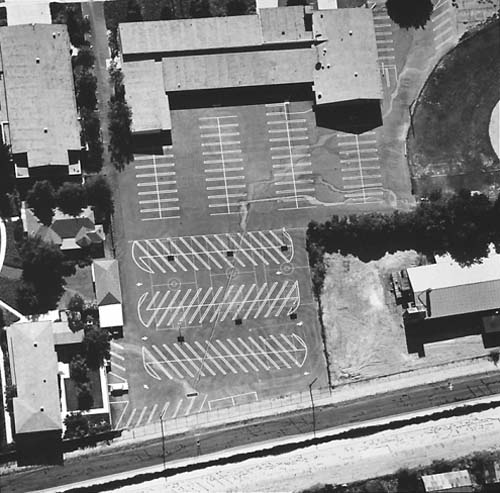
Ed Ruscha, Parking Lots (6), 1967/99, downloaded from Daniel Templon
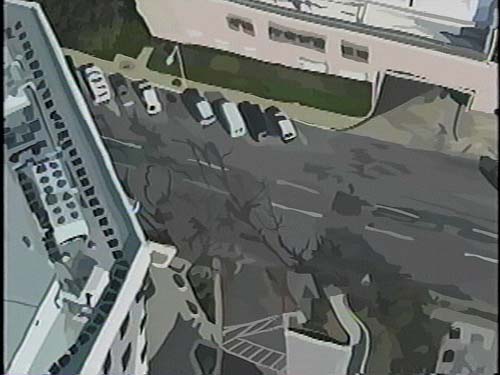
Video still from the film "Waking Life" (2001) by Richard Linklater
In 1960, American conceptual/pop artist Ed Ruscha finished art school in LA. That same year, Texan filmmaker Richard Linklater was born. In 1967, the year that I was born, Ruscha made the unpreposessing art book, Thirtyfour Parking Lots in Los Angeles. In 198-something, I first encountered Ruscha's art books while attending art school at NSCAD. My initial reaction to "Thirtyfour Parking Lots in Los Angeles" was a flush of relief. I recently had a similar experience watching Richard Linklater's film "Waking Life."
Hal Foster: "...Ruscha has dampened his art in a way that nonetheless allows it to be distinctive: a deadpan-ness - funny, desolate, sometimes both - is conveyed in his homely shots of solitary gas stations or aerial images of empty parking lots..."
Richard Linkater: "One thing we’ve all learned is that the corporate father has no interest in you as an individual. So if people could be aware of that, and stay on their toes, adapt … that’s a good thing."
Metropolitain Museum of Art's Timeline of Art History: "Ruscha's books paid tribute to and slyly parodied the romantic vision of the road epitomized by writers and artists such as Jack Kerouac and Robert Frank, while also subverting the rapidly expanding market for what the artist described as "limited edition, individual, hand processed photos."
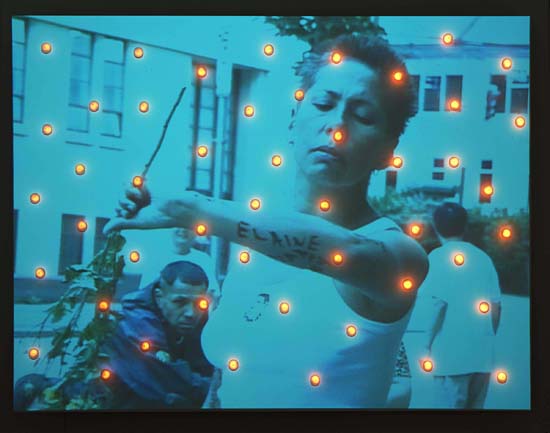
Rebecca Belmore, “The Named and the Unnamed”, 2002 (Photo: Howard Ursuliak).This image was provided for download here.
I am really pleased that Rebecca Belmore is going to represent Canada at the Venice Biennale next year. She is a tough and exciting performance artist from the First Nations. The first time I saw her, in 1997, she performed a strong, scary tribute to Dudley George, ("the first Indigenous person this century to be killed in a land rights dispute in Canada") at a 7A*11d event at the skanky old Symptom Hall in Toronto (now that place worn't no boo-teek hotel).
In 2002 Belmore was part of the group show Houseguests in which contemporary artists infiltrated the AGO's historic Grange property, Toronto's "oldest brick building" (fer gawd's sake). Belmore took over the master bedroom, and slept under a bearskin blanket in the 19th-century four-poster bed.
The video still above is performance footage projected onto a wall that has been studded with light bulbs. I saw this installation at the Art Gallery of Ontario in 2003. The performance is a long ritural "in response to the horrific unfolding of evidence around the serial killing of women from Vancouver's skid row." Belmore is a hard-core performer, with onstage charisma and an unsually unsettling undertone of violence. In the next shot, she takes that rose and pulls it, thorns and all, through her teeth. Another element that I really liked was when she put on a long red dress, picked up a hammer, and started forcefully nailing the dress to a back-alley telephone pole. Belmore is strong, and she knows how to wield a hammer with conviction. Once all the loose pieces of garment were nailed into the wood, Belmore proceeded to tear herself away, rending the dress and leaving it to dangle in tatters. I was impressed by the performance (which had many more elements than I am describing here) but also by the simple distracting beauty of the light bulbs shining through the video. All this to say, Canada is gonna have some kick-ass representation at the big show next summer.
Well I'm back online and catching up with the foofoorah about changes to the Canada Council's visual arts program. There are spirited threads on both Zeke's Gallery and Simpleposie with refreshingly crabby provocations by Timothy Comeau of Goodreads and refreshingly outraged response from various art-types. The discussion is polarising, which is entertaining, but of course, as Cedric Caspesyan points out, there's a loss whenever that happens. One very important thing to keep in mind is that most Canadian artists do not currently get funding from the Canada Council. There is a myth that we can float along on grants in this country, making esoteric and unpopular art that might never be shown. Some of the people who make art get government support some of the time, and a very very few of the people who make art get grants on a regular basis (but even for them there are no guarantees). In practice we are not that different from the USA, where artists whose work doesn't commodify well spend a lot of their time hustling money from private grants, bursaries, residencies, day jobs, gallery jobs, etc. The Canada Council isn't currently proposing to increase the amount of money or anything, so we are arguing about statements of principle. And in this respect the younger rabble-rouser types (and I include myself in this category, though I am not sooo young, because I will entertain doubts about the status quo) have been lucky to grow up under a government that, until now, openly states the importance of arm's length support for creation of art. Could we even pinpoint and begin to separate the explorative or experimental elements of our artistic personalities that were formed in the context of this ideal? That said, I'm glad Timothy Comeau is ranting and Zeke is stating his preference for the new, exhibition-oriented agenda, because ideals require scrutiny. If we care, we have to be able to question and change.
Comeau is dead right when he says: "It is not fair to think that the Canada Council's programs, nor our whole artworld infrastructure, as sustainable as anything else within the current system manifested by its bureaucracies." But he is wrong when he says: "In art, in luxury, in anything, it's only worth something if somebody wants it." Acquistion is only one method (and I would also pose it is restrictive) of interacting with art, but it is the only means available in the so-called "free" market place. Right now, with the Canada Council as it stands, we participate as a society in an open statement that culture has value beyond commodity. Tell me, is that not cool and worth defending?